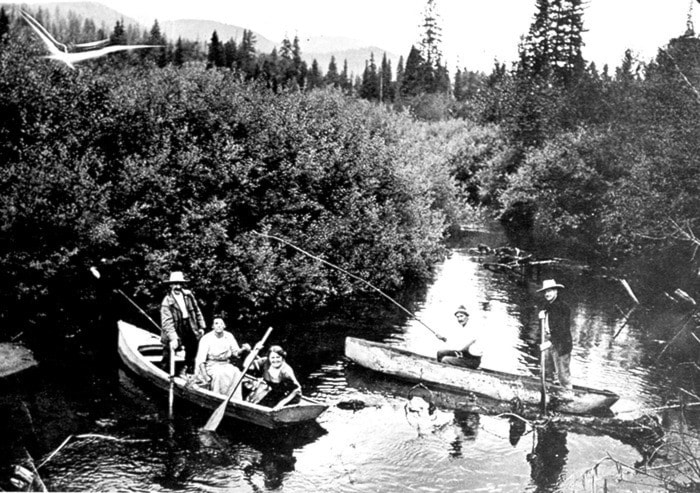When he failed to return from his trap line in December 1934, Ben Shaw’s friends in Rossland started to worry. It was unthinkable that the gregarious Sheep Creek septuagenarian would pass up the merriment of the season at his favourite Rossland pub. A search party set out on snowshoes, to discover his Sheep Lake (Nancy Greene Lake) cabin empty, and no evidence of recent activity.
By this time, Ben was a living legend. He left his native New Brunswick to answer the call of the untamed West. Near Colville he found his life partner in Olive La Fleur, a half-native woman that accepted the name of Babe. He owed her his life as she was able to nurse him back to health after he took several bullets while interceding in a gunfight on their ranch. As her brothers were not too keen on the union, the couple fled across the border and entered Canadian soil in Boundary Country. Both were subpoenaed to the subsequent murder trial held in October 1890, but refused to cross the border to attend.
This version of the story is supportable by documents. Other sources seem to have spun the story into myth: that Ben was one of the original stakeholders of Grand Prairie (Grand Forks); that he turned down an offer to join the Hall Brothers in the staking of the Silver King claim; that he was similarly invited to join the original discoverers of the Red Mountain riches, but lost out by the unfortunate gunfight.
Supposedly he had volunteered to obtain supplies for Joe Morris and his partners while they guarded their claims. In the process he took on a packing partner, who convinced him to accompany him to Colville to retrieve money that was owing to him by a man named Jenkins. Instead of squaring up, Jenkins shot Dailey dead, and then riddled Ben with five bullets as he tried to intercede. Thus he lost a chance at a fortune, but gained a faithful wife.
Packing supplies to mining operations brought in some much needed income. The Dewdney Trail drew them westward, and in 1894 they built a fine log house on a fifty acre lot several miles upstream from the Trail’s crossing of Sheep Creek. They largely lived off the land, and occasionally walked the Dewdney Trail to Rossland to obtain supplies and connect with civilization. The latter connected with Ben a little too strongly and he found a second home in Sam Irwin’s hotel and pub. Although Sam profited from his business, much of it was on credit. The hotel owner was, however, a faithful friend.
Ben’s packing activities were gradually supplemented by the development of a fishing camp at his ranch, and — in the off-season — by trapping in the headwaters of Sheep Creek.
Two children were born to the couple: Josephine, and later, a boy named after his father. He died in infancy and was buried in a grove of evergreens on the property. Rob Dorey’s boyhood is punctuated by remembrances of Josephine’s tender care and solemn visits to the lonely grave during his family’s stays at the ranch.
Late in October 1934, Sam Irwin and his son John accompanied Ben to his Sheep Lake cabin with his winter supplies. John and a friend returned the next day with the final shipment. They found Ben in an anxious state as part of the cabin roof had collapsed, soaking his sleeping gear. After lunch, the boys departed. They were the last to see him alive.
The following May plans were launched to prepare a float plane that would bring a search party to the lake as soon as ice was gone. That attempt was not necessary, as Sam Irwin and Wilfred Dorey set out on foot early on May 22 and the next day located Ben’s body in shallow water about a mile east of Sheep Lake outlet. A raft was nearby, suggesting Ben had used it to move to the site with trapping equipment.
As the body was badly decomposed, death must have come not long after Ben had settled in. It may have been the day after arrival, as John Irwin found the dishes on the table as they were during their last lunch together. Had Ben died in January, as was suggested, little decomposition would have occurred during the cold of winter. Most likely he died in late October or early November 1934.
One of Ben’s cabins survives, close to the ski trail that commemorates his name.
(I am indebted to Rob Dorey for his files and reminiscences.)
Walter Volovsek’s website can be found at trailsintime.org
Previous installments in this series
Lilette Mahon: A mentor’s gift
Edward Mahon: Searching for a legacy
Edward Mahon: A stimulating childhood
Intrigues: Castlegar’s lacklustre childhood
Perceptions: Adrift on the River of Life
